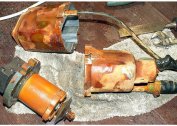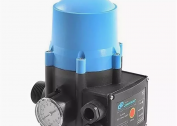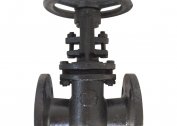To provide a private house with water at any time of the day, you need to buy and install an automatic pumping station for domestic water supply. If you look at the construction supermarket, you can see many models and brands. It is possible to determine which one to choose only after a detailed study of the technical characteristics, reviews and conditions in the area where the well or well is located.
NS device
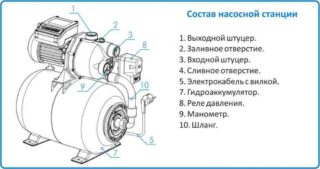 Any automatic pumping station consists of several nodes that are responsible for individual actions:
Any automatic pumping station consists of several nodes that are responsible for individual actions:
- a surface pump pumps water through a pipe or hose;
- a hydraulic accumulator with a rubber bulb accumulates it in reserve;
- the engine drives the pump;
- A pressure switch detects and monitors when it is necessary to turn equipment on or off.
Depending on how the relay settings are made, the station will turn on and off more often or less. The service life depends on the number of on / off cycles, so if you wish, it is better to configure the device, you should consider how many times a day it will operate.
The principle of operation of an automatic water supply station
 Despite the diverse selection of designs, the principle of operation is the same. Automatic stations operate without human intervention. The process of pumping and water flow depends on the settings of the equipment. Water supply stations are set up at the plant, but if needs change, they can be changed independently.
Despite the diverse selection of designs, the principle of operation is the same. Automatic stations operate without human intervention. The process of pumping and water flow depends on the settings of the equipment. Water supply stations are set up at the plant, but if needs change, they can be changed independently.
The pump begins to pump water from the well after the pressure in the membrane tank drops, that is, in the house include some kind of plumbing fixture - a faucet in the kitchen, in the bathroom, shower, washing machine or dishwasher. When water is collected in the accumulator and the pressure gauge shows the upper limit of the pressure settings, the unit shuts off automatically.
Advantages and disadvantages
As in any equipment, pumping stations have their positive and negative sides. The positive include:
- automatic mode - the unit does not require constant monitoring;
- You can choose a pump depending on the needs of the family, so as not to overpay for performance;
- the presence of storage capacity increases the resource of the station, since it does not work in a constant mode;
- maintaining a constant pressure in the system, which is important for most household appliances and plumbing devices;
- On many modern water supply units there are several degrees of protection at once, as well as a non-return valve against draining water and filters from clogging and damage to internal parts.
Of the minuses:
- the unit is noisy during operation, so it’s better not to put it in a living room, a basement or a barn, preferably warm, so that less condensation forms, due to which the case quickly rusts;
- if the productivity of the well is less than the productivity of the pump, there will be constant interruptions in the house with water;
- the station operates at a limited depth of up to 8 meters, so it is not suitable for all wells;
- devices with all levels of protection are expensive, so you will not be able to save on a purchase;
- if you buy silent equipment for installation in the house, it will cost even more.
Before thinking about buying a pumping station, you need to check whether the conditions in which it will work are suitable. It may be worth considering a submersible or surface pump of low power, which corresponds to the depth and performance of the source.
Criterias of choice
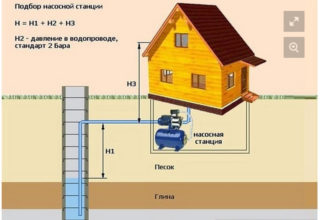 In order not to overpay for excess power and energy consumption, and at the same time not to suffer due to lack of pressure, you need to know what indicators of the water supply station to pay attention to when buying.
In order not to overpay for excess power and energy consumption, and at the same time not to suffer due to lack of pressure, you need to know what indicators of the water supply station to pay attention to when buying.
First of all, this is the performance of the unit: how many cubic meters of liquid it is able to pump for a certain unit of time. This indicator directly depends on the power that the engine consumes.
The second moment - pressure - the magnitude of the water column. Here you need to know the exact length of the entire line from the well to the water intake point in the house. The value is determined in meters of water, while horizontally 10 m is 1 meter vertically. In order to calculate correctly whether a pump station with a certain head for a section is suitable, one needs to measure the depth of the well, to this number add the vertical length of the pipeline divided by 10. For example: the depth of the well is 4 meters, the length of the vertical section of the pipe is 30 m. 4 + 3 = 7 m. For this situation, you need a station with a water pressure of at least 7 m water column.
The protection levels are of great importance - from idling (dry running), filters, overheating sensors, non-return valve. If the water level suddenly drops in the well, the station will not turn on until the suction pipe is lowered lower. On the one hand, it will take time to find out the cause of the equipment failure, on the other hand, it will save the device from damage. Pumps with protection are more expensive but last longer.
It plays a role which brand / manufacturer to choose for continuous operation. Cheap equipment is absolutely not suitable for long-term operation. All parts of such devices are made of plastic, so they wear out quickly. The most popular Italian and German brands, but they are expensive, as they have high quality characteristics. Among Chinese models, you can also find good appliances, but they will not be cheap. The best option is expensive domestic models. They are cheaper than Italian and German, but they are made with high quality.
For deep wells, it is necessary to install a pumping station with an ejector, without which it will be impossible to lift water from a depth of more than 10 m. This is expensive equipment. With a limited budget, you should consider buying a simple submersible pump and installing a storage tank.
Installation and operation
Installation of a pumping station takes a minimum of time, if you plan to put it in a prepared room. If you need to equip the caisson near the well, it will take more time and additional costs. It is necessary to make a concrete cushion for the equipment, fix it, and then connect it to the rest of the highway.
To connect to a home wiring, the pump must be connected to an external pipe. Thanks to a convenient collector, this is not difficult. After the pipes are laid and connected, carry out the first start. At the same time, trenches cannot be filled up, as completion of the highway may be required. After checking when the plumbing fixtures are turned on in the house, it is recommended to leave the trenches open for a couple of days. If during this time there are no failures, the highway is bombarded with earth and rammed.
NA Cost
Prices for automatic pumping stations for a private house depend primarily on the power and performance of the equipment, then on the availability of protective devices and sensors. Ejector installations are more expensive, but can be used at great depths.
Imported models have proven themselves in the domestic market due to constant quality control at all stages of production, as well as the use of expensive materials.

